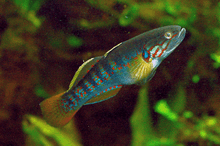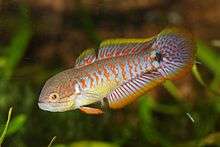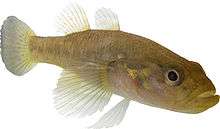Eleotridae
Eleotridae is a family of fish commonly known as sleeper gobies, with about 34 genera and 180 species.[1] Most species are found in the tropical Indo-Pacific region, but there are also species in subtropical and temperate regions, warmer parts of the Americas and near the Atlantic coast in Africa. While many eleotrids pass through a planktonic stage in the sea and some spend their entire lives in the sea; as adults, the majority live in freshwater streams and brackish water.[2] One of its genera, Caecieleotris, is troglobitic.[3] They are especially important as predators in the freshwater stream ecosystems on oceanic islands such as New Zealand and Hawaii that otherwise lack the predatory fish families typical of nearby continents, such as catfish. Anatomically, they are similar to the gobies (Gobiidae), though unlike the majority of gobies, they do not have a pelvic sucker.[2]
| Eleotridae | |
|---|---|
 | |
| Mogurnda mogurnda | |
| Scientific classification | |
| Kingdom: | Animalia |
| Phylum: | Chordata |
| Class: | Actinopterygii |
| Order: | Gobiiformes |
| Family: | Eleotridae Bonaparte, 1835 |
Like the true gobies, they are generally small fish that live on the substrate, often amongst vegetation, in burrows, or in crevices within rocks and coral reefs. Although goby-like in many ways, sleeper gobies lack the pelvic fin sucker and that, together with other morphological differences, is used to distinguish the two families. The Gobiidae and Eleotridae likely share a common ancestor and they are both placed in the order Gobiiformes, along with a few other small families containing goby-like fishes.[2]
Dormitator and Eleotris, two of the most widespread and typical genera, include a variety of species that inhabit marine, estuarine and freshwater habitats. Among the largest members of the family are predatory species such as the bigmouth sleeper (Gobiomorus dormitor) at up to 90 cm (3.0 ft) from freshwater near the West Atlantic region[4] and the fat sleeper (Dormitator maculatus), which grows to 70 cm (2.3 ft) and is widely found in fresh to brackish and shallow marine waters of the southeastern United States and Mexico,[5] However, most are much smaller, such as the fresh- and brackish-water species from Australia and New Guinea, including Hypseleotris, known locally as gudgeons (not to be confused with the Eurasian freshwater cyprinid Gobio gobio, also known as the gudgeon and after which the Australian sleeper gobies were likely named).[6] A few of these, such as the empire gudgeon (H. compressa) and peacock gudgeon (Tateurndina ocellicauda), are sometimes kept in aquariums. The smallest in the family are the Amazonian Leptophilypnion with a standard length of less than 1 cm (0.4 in).[7]
Taxonomy
.jpg)

The family has been divided into three subfamilies: Butinae, Eleotrinae and Milyeringinae.[1] However, because of the deep divergence between the three, some authorities have recommended splitting them into separate families: Butidae, Eleotridae and Milyeringidae.[8][9] The 5th edition of Fishes of the World follows this classification and this means that the following genera are currently included within the Eleotridae.[10] However, the family Xenisthmidae is regarded as a synonym of the Eleotridae, according to the 5th Edition of Fishes of the World.[11]
- Allomicrodesmus Schultz, 1966
- Allomogurnda Allen, 2003
- Belobranchus Bleeker, 1857
- Bunaka Herre, 1927
- Caecieleotris Walsh & Chakrabarty, 2016[3]
- Calumia Smith, 1958
- Dormitator Gill, 1861
- Eleotris Bloch & Schneider, 1801
- Erotelis Poey, 1860
- Giuris Sauvage, 1880
- Gobiomorphus Gill, 1863
- Gobiomorus Lacépède, 1800
- Guavina Bleeker, 1874
- Gymnoxenisthmus Gill, Bogorodsky & Mal, 2014 [12]
- Hemieleotris Meek & Hildebrand, 1916
- Hypseleotris Gill, 1863
- Kimberleyeleotris Hoese & Allen, 1987
- Leptophilypnion Roberts, 2013[13]
- Leptophilypnus Meek & Hildebrand, 1916
- Microphilypnus Myers, 1927
- Mogurnda Gill, 1863
- Paraxenisthmus Gill & Hoese, 1993
- Philypnodon Bleeker, 1874
- Ratsirakia Maugé, 1984
- Rotuma Springer, 1988
- Tateurndina Nichols, 1955
- Tyson Springer, 1983
- Xenisthmus Snyder, 1908
References
- Froese, Rainer, and Daniel Pauly, eds. (2017). "Eleotridae" in FishBase. September 2017 version.
- Helfman, G.S., Collette, B.B. & Facey, D.E. (1997): The Diversity of Fishes. Wiley-Blackwell Publishing. p. 264. ISBN 978-0-86542-256-8
- Walsh, S.J. & Chakrabarty, P. (2016): A New Genus and Species of Blind Sleeper (Teleostei: Eleotridae) from Oaxaca, Mexico: First Obligate Cave Gobiiform in the Western Hemisphere. Copeia, 104 (2): 506-517.
- Froese, Rainer and Pauly, Daniel, eds. (2017). "Gobiomorus dormitor" in FishBase. September 2017 version.
- Hoedeman, J.J. (1974): Naturalists' guide to fresh-water aquarium fish. Sterling Publishing. p. 1152. ISBN 978-0-8069-3722-9
- Riehl, R. & Baensch, H.A. (1997): Aquarium Atlas (Volume 2). Voyageur Press. p. 1216. ISBN 978-1-890087-06-7
- Roberts, T.R. (2013). Leptophilypnion, a new genus with two new species of tiny central Amazonian gobioid fishes (Teleostei, Eleotridae). Aqua, International Journal of Ichthyology, 19 (2): 85-98.
- Chakrabarty, P. (2010): Status and phylogeny of Milyeringidae (Teleostei: Gobiiformes), with the description of a new blind cave-fish from Australia, Milyeringa brooksi, n. sp. Zootaxa 2557: 19–28.
- Thacker, C. (2011). Systematics of Butidae and Eleotridae. in Patzner, R.; J.L. Van Tassell; and M. Kovacic. The Biology of Gobies. Verlag Science Publishers. ISBN 1-57808-436-9
- Nelson, JS; Grande, TC & Wilson, MVH (2016). "Classification of fishes from Fishes of the World 5th Edition" (PDF). Retrieved 10 June 2018.
- Nelson, JS; Grande, TC & Wilson, MVH (2016). Fishes of the World (5 ed.). John Wiley & Sons. pp. 328–329. ISBN 1119220815.
- Gill, A.C., Bogorodsky, S.V. & Mal, A.O. (2014). "Gymnoxenisthmus tigrellus, new genus and species of gobioid fish from the Red Sea (Gobioidei: Xenisthmidae)" (PDF). Zootaxa. 3755 (5): 491–495. doi:10.11646/zootaxa.3755.5.9.CS1 maint: multiple names: authors list (link)
- Roberts, T.R. (2013): Leptophilypnion, a new genus with two new species of tiny central Amazonian gobioid fishes (Teleostei, Eleotridae). aqua, International Journal of Ichthyology, 19 (2): 85-98.
